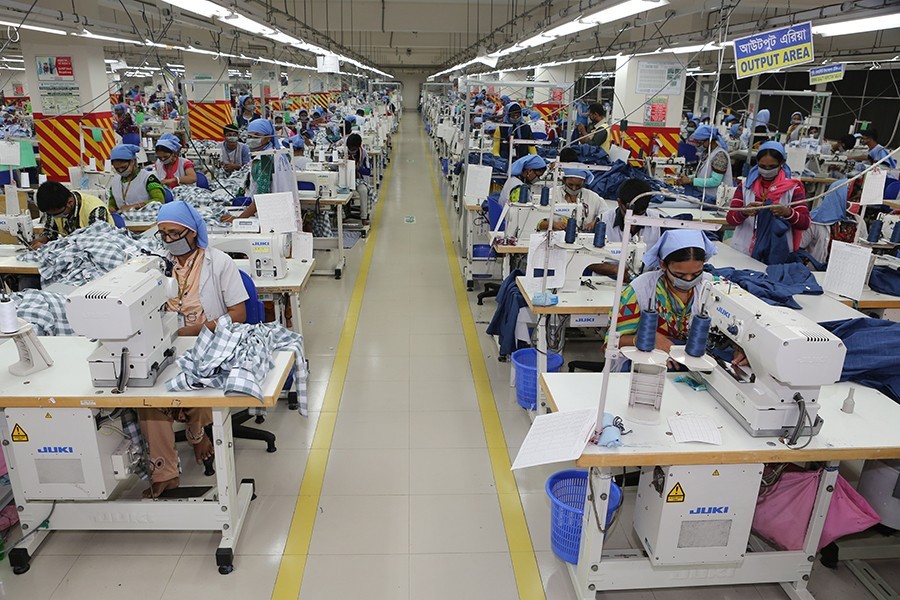Apparel sector leaders on Wednesday demanded immediate publication of the revised Bangladesh National Building Code (BNBC) to help the sector avoid costly western prescriptions further.
The leaders of Bangladesh Garment Manufacturers and Exporters Association (BGMEA) also disagreed with the possibilities of achieving the target of US$ 50 billion in export earnings from the readymade garment (RMG) sector by 2021.
"We are yet to revise our aged-old BNBC even in 2019 though the work on its revision begun in 2015," BGMEA president Dr Rubana Huq told a workshop at the Bangabandhu International Conference Centre in the capital.
Planning minister MA Mannan was present as chief guest at the workshop, presided over by planning division secretary Nurul Amin.
The inception workshop of the proposed study on 'Supply Chain Resilience of RMG Sectors in Bangladesh' was organised by the National Resilience Programme (NRP) being implemented by the programming division of planning commission.
After the Rana Plaza building collapse, the industry had to invest a huge amount of money to implement the safety measures in line with the prescriptions of the western retailers' platforms - Accord and Alliance - that missed the national context, the BGMEA chief argued.
As a result, the prescription disrupts and ends up being super expensive for the sector, she said, adding that US$ 1.5 billion has been invested in installing the equipments only for fire safety during the last six years.
World class fire hydrant system and fire alarms have been installed but those are not working due to humidity, she alleged.
"Don't allow others to suppress us," she said, demanding publication of the revised BNBC shortly which is possible if all concerned work together.
Regarding the $ 50 billion export earnings target, she said the target was fixed after the Rana Plaza building collapse for some reasons.
"But I disagree with the target taking the current scenario of the sector as export earnings declined by more than 6.0 per cent in last five months," she said, adding the World Trade Organization has also reduced the global consumption rate to 1.2 per cent from 1.8 per cent.
She said the target should be focused on value addition and retention as the number only creates confusion.
Ms Huq suggested incorporating other sectors in the study that is expected to develop resilience strategies for the supply chain of RMG in the country.
Professor Dr Moinul Hossain of Islamic University of Technology made a presentation describing the background on how resilient the RMG sector is; objective, scope, methodology, probable outcomes of the study that is scheduled to publish in April next year.
The objectives are to review existing supply chain system of RMG sector, implication of natural disaster and climate change-related risks, impact of natural disaster on transportation network, future RMG trade on supply chain system and formulate strategies to improve and strengthen the resilience of RMG sector supply chain, he said.
He, however, identified increased lead time and cost due to disruption in procurement and shipment of goods, lack of linkages and co-ordination among related industries in the value chain, dependence on imported inputs and limited variety of finished products and fall of orders are the issues of concern for RMG supply chain in the country.
Local RMG makers are taking relatively longer lead time ranging from 90 days to 120 days while Sri Lankan lead time is 19 to 45 days, 40-50 days for China, and 50-70 days for India, he noted.
Terming resilience 'very important' for the survival and moving the economy forward, minister MA Mannan stressed the need to strengthen the overall capacity by skill development of the workforce to cope up with the future challenges.
Speakers at the workshop emphasised on disaster and climate resilience in the supply chain process of the RMG sector in Bangladesh for sustaining the economic growth.
Though Bangladesh has achieved a lot in overall disaster management, yet vulnerability of industry sector to mega disasters is not well addressed, they said.
This is the right time to assess the disaster risks in industry sector and promote business continuity plan for minimizing disaster risks, particularly risk of disruption in supply chain process, they opined.
As the RMG sector has created employment for millions of workers and making significant contribution to the country's economy, this sector should be prepared for minimizing disaster risks and supply chain process of this sector needed to be resilient, speakers said.
They also suggested risk mapping in supply chain process considering hazards due to natural disasters and climatic extreme event such as sea level rise, flood, water-logging and earthquake.
The recommendations also included taking special measures to protect the industrial units located in the coastal belts and other disaster-prone areas of the country.


